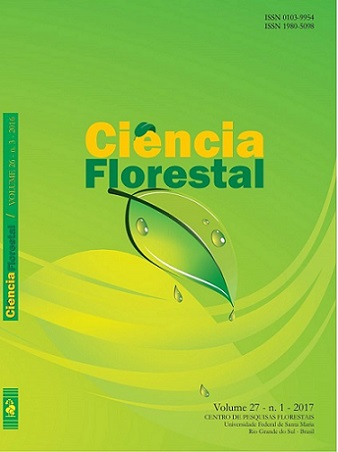DIVERSIDADE FLORÍSTICA E EQUABILIDADE EM FRAGMENTOS FLORESTAIS USANDO REDES NEURAIS ARTIFICIAIS
DOI:
https://doi.org/10.5902/1980509826454Palavras-chave:
diversidade biológica, Cerrado, MLP.Resumo
Este estudo teve como objetivo avaliar a eficiência da predição dos índices de diversidade de Shannon (H’) e de Equabilidade de Pielou (J) em fragmentos florestais do Cerrado brasileiro a partir de índices de vegetação e métricas da paisagem empregando redes neurais artificiais (RNA). Utilizaram-se redes anteroalimentadas (feedforward), treinadas por meio do algoritmo da retropropagação do erro (back propagation). As variáveis utilizadas como entradas das RNA para a estimação simultânea dos índices foram: as categóricas (índices H’ e J) e as numéricas relacionadas às médias e desvios padrão dos índices de vegetação (NDVI, SAVI, EVI, MVI5 e MVI7) e métricas da paisagem (AREA, GYRATE, SHAPE, CONTIG, CORE e ENN). Foram gerados cinco modelos de RNA a partir das relações funcionais entre as variáveis numéricas inerentes aos índices de vegetação em duas épocas, uma seca (junho) e outra chuvosa (fevereiro). A arquitetura das redes foi a Multilayer Perceptron (MLP) para estimar simultaneamente H’ e J: 500 utilizando os índices de vegetação na época úmida (100 para cada índice de vegetação) e 500, na seca (100 para cada índice de vegetação). Foi avaliada a precisão, acurácia e realismo biológico das RNA. As redes construídas na época chuvosa e seca que utilizaram os índices de vegetação MVI5 (Moisture Vegetation Index) e SAVI (Soil Adjusted Vegetation Index), respectivamente, foram mais adequadas, precisas e realistas biologicamente para estimar, simultaneamente, os índices de H’ e de J. A modelagem por RNA demonstrou-se adequada para estimar os índices de diversidade e equabilidade.
Downloads
Referências
BLACKARD, J. A.; DEAN, D. J. Comparative accuracies of artificial neural networks and discriminant analysis in predicting forest cover types from cartographic variables. Computers and Electronics in Agriculture, Amsterdam, v. 24, p. 131-151, 1999.
BRADSHAW, C. J. A. et al. Using artificial neural networks to model the suitability of coastline for breeding by New Zealand fur seals (Arctocephalus forsteri). Ecological Modelling, Amsterdam, v. 148, p. 111-131, 2002.
CABACINHA, C. D.; CASTRO, S. S. Relationships between floristic diversity and vegetation indices, forest structure and landscape metrics of fragments in Brazilian Cerrado. Forest Ecology and Management, Amsterdam, v. 257, p. 2157-2165, 2009.
CERQUEIRA, E. O.; ANDRADE, J. C.; POPPI, R. J. Redes neurais e suas aplicações em calibração multivariada. Química Nova, São Paulo, v. 24, n. 6, p. 864-873, 2001.
FERNANDES, A. M. et al. Development of neural network committee machines for automatic forest fire detection using lidar. Pattern Recognition, Amsterdam, v. 37, p. 2039-2047, 2004.
FOODY, G. M.; CUTLER, M. E. J. Mapping the species richness and composition of tropical forests from remotely sensed data with neural networks. Ecological Modelling, Amsterdam, v. 195, p. 37-42, 2006.
GORGENS, E. B. et al. Estimação do volume de árvores utilizando redes neurais artificiais. Revista Árvore, Viçosa, MG, v. 33, n. 6, p. 1141-1147, 2009.
HAYKIN, S. Redes neurais: princípios e prática. 2. ed. Porto Alegre: Bookman, 2001. 900 p.
INGRAM, J. C.; DAWSON, T.; WHITTAKER, R. J. Mapping tropical forest structure in southeastern Madagascar using remote sensing and artificial neural networks. Remote Sensing of Enviroment, Amsterdam, v. 94, p. 491-507, 2005.
KALACSKA, M. et al. Ecological fingerprinting of ecosystem succession: Estimating secondary tropical dry forest structure and diversity using imaging spectroscopy. Remote Sensing of Environment, Amsterdam, v. 108, p. 82-96, 2007.
KUPLICH, T. M. Classifying regenerating forest stages in Amazônia using remotely sensed images and a neural network. Forest Ecology and Management, Amsterdam, v. 234, p. 1-9, 2006.
MABVURIRA, D.; MIINA, J. Individual-tree growth and mortality models for Eucalyptus grandis (Hill) Maiden plantations in Zimbabwe. Forest Ecology and Management, Amsterdam, v. 161, p. 231-245, 2002.
MAEDA, E. E. et al. Predicting forest fire in the Brazilian Amazon using MODIS imagery and artificial neural networks. International Journal of Applied Earth Observation and Geoinformation, Amsterdam, v. 11, p. 265-272, 2009.
MONJEZI, M.; BAHRAMI, A.; VARJANI, A. Y. Simultaneous prediction of fragmentation and flyrock in blasting operation using artificial neural networks. International Journal of Rock Mechanics & Mining Sciences, Amsterdam, v. 47, p. 476-480, 2010.
OLIVEIRA, V. A. et al. Diagnóstico agroambiental do entorno do Parque Nacional das Emas: 1a. Fase, pedologia, aptidão agrícola e uso atual das terras. Gioânia: Agência Rural, 2003.
PESSOA, A. S. A. et al. Mineração de dados meteorológicos para previsão de eventos severos. Revista Brasileira de Meteorologia, São José dos Campos, v. 27, n. 1, p. 61-74, 2012.
SCRINZI, G.; MARZULLO, L.; GALVAGNI, D. Development of a neural network model to update forest distribution data for managed alpine stands. Ecological Modelling, Amsterdam, v. 206, p. 331-346, 2007.
SOARES, F. A. A. M. N. et al. Recursive diameter prediction and volume calculation of eucalyptus trees using Multilayer Perceptron Networks. Computers and Electronics in Agriculture, Amsterdam, v. 78, p. 19-27, 2011.
STATSOFT. Statistica (data analysis software system), version 7. Oklahoma: Statsoft, 2007. Disponível em: <http://www.statsoft.com>. Acesso em: 10 jul. 2013.
TAWADROUS, A. S.; KATSABANIS, P. D. Prediction of surface blast patterns in limestone quarries using artificial neural networks. International Journal for Blasting and Fragmentation, London, v. 10, n. 4, p. 233-242, 2009.
Downloads
Publicado
Como Citar
Edição
Seção
Licença
A CIÊNCIA FLORESTAL se reserva o direito de efetuar, nos originais, alterações de ordem normativa, ortográfica e gramatical, com vistas a manter o padrão culto da lingua, respeitando, porém, o estilo dos autores.
As provas finais serão enviadas as autoras e aos autores.
Os trabalhos publicados passam a ser propriedade da revista CIÊNCIA FLORESTAL, sendo permitida a reprodução parcial ou total dos trabalhos, desde que a fonte original seja citada.
As opiniões emitidas pelos autores dos trabalhos são de sua exclusiva responsabilidade.







